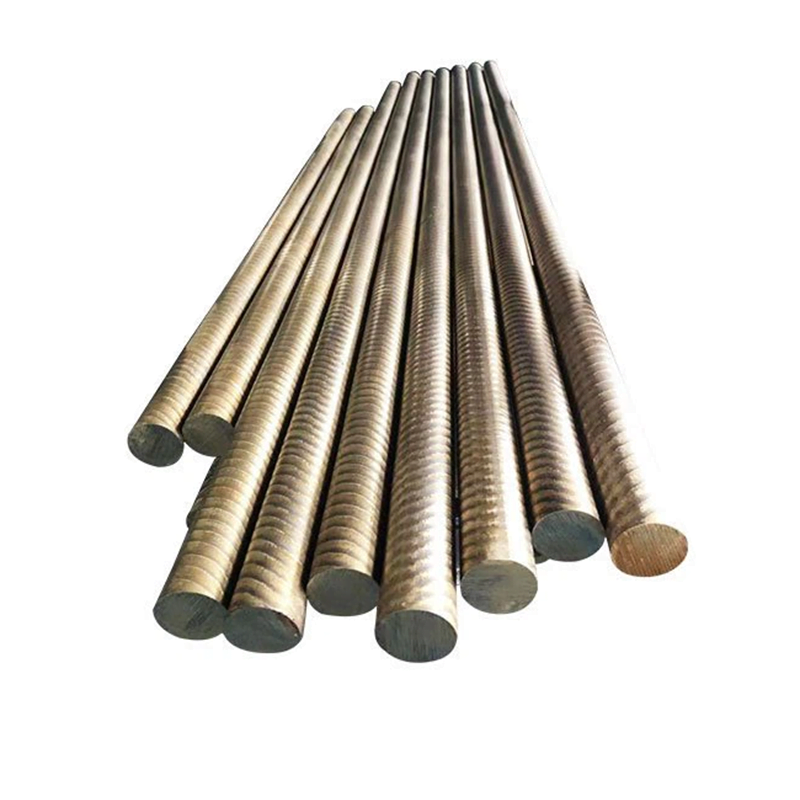
在機械工程的世界中,選擇正確的軸承材料對於確保最佳性能,壽命和成本效益至關重要。鋁製青銅已成為許多軸承應用的流行選擇,為理想的特性和合理的成本提供了獨特的平衡。本文探討了鋁製青銅在機械軸承中的使用,從而研究了其性能特徵及其在成本效益方面的測量方式。
了解鋁青銅
鋁製青銅是一個銅基合金系列,含有鋁作為主要合金元件,通常具有其他元素,例如鐵,鎳和錳。這些合金以其:
- 高強度
- 優異的耐腐蝕性
- 耐磨性好
- 低摩擦特性
- 導熱係數
軸承應用中的鋁青銅
鋁青銅廣泛用於各種軸承應用,包括:
- 普通軸承和襯套
- 推力墊圈
- 耐磨板
- 齒輪軸承
- 重型機械中的滑動元素
它在這些應用中的受歡迎程度源於其獨特的屬性組合,使其非常適合苛刻的環境。
性能特點
讓我們研究鋁製青銅軸承的關鍵性能特徵:
1。強度和耐用性
鋁製青銅軸承具有高強度和出色的耐用性。它們可以承受重重的負荷並在壓力下保持其結構完整性。這使它們適合在可靠性至關重要的重型機械和設備中的應用。
2。戴阻力
鋁製青銅的傑出特徵之一是其出色的耐磨性。該屬性在應用程序中尤其重要,因為它直接影響了組件的壽命和性能。鋁製青銅軸承可以在長時間使用時保持其尺寸穩定性和表面飾面,從而減少了頻繁更換的需求。
3.耐腐蝕
鋁青銅具有出色的耐腐蝕性,尤其是在海洋和工業環境中。該特性使其成為暴露於惡劣條件的軸承的理想選擇,例如化學加工廠或離岸設備的軸承。
4。低摩擦係數
鋁製青銅具有自然低的摩擦係數,這對軸承應用是有益的。該特性有助於減少由於摩擦而導致的能源損失,並最大程度地減少交配表面的磨損。
5。導熱率
鋁青銅的良好導熱性有助於散發運行過程中產生的熱量。這在高速或高負載應用程序中尤其有利,在這些應用中,在高速或高載量可能會引起人們的關注。
成本考慮
儘管鋁製銅提供了出色的性能特徵,但重要的是要考慮其與替代軸承材料有關的成本。以下是鋁青銅與一些常見軸承材料的比較:
| 材料 | 相對成本 | 耐磨性 | 耐腐蝕性能 | 力量 |
|---|---|---|---|---|
| 鋁青銅 | 緩和 | 優秀的 | 優秀的 | 高的 |
| 巴比特 | 低的 | 貧窮的 | 好的 | 低的 |
| 青銅 | 緩和 | 好的 | 好的 | 緩和 |
| 鋼 | 低的 | 好的 | 貧窮的 | 高的 |
| 不銹鋼 | 高的 | 好的 | 優秀的 | 高的 |
如我們所見,鋁製青銅在成本和性能方面提供了平衡的概況。雖然它可能比Babbitt或Standard Steel(例如Babbitt或Standard Steel)更昂貴,但其出色的特性通常證明在許多應用中的額外成本是合理的。
成本效益分析
在考慮用於軸承應用的鋁製青銅時,必須進行徹底的成本效益分析。以下是要考慮的一些因素:
- 初始成本與終身成本:雖然鋁製青銅軸承的初始成本可能更高,但它們的壽命較長和維護需求的減少可能會導致整體壽命成本較低。
- 性能要求:在高性能至關重要的應用中,鋁製青銅的出色特性可以超過更高的初始成本。
- 環境因素:在腐蝕性或高衣環境中,鋁製青銅的耐用性可以隨著時間的推移而節省大量成本。
- 停機費用:鋁青銅軸承的壽命和可靠性更長,可以減少工業應用中昂貴的停機時間。
- 能源效率:鋁製青銅的低摩擦係數可以在某些應用中節省能源,從而抵消了較高的材料成本。
申請示例
為了說明性能和成本之間的平衡,讓我們看一下兩個常見的應用:
海洋螺旋槳軸軸承
在此應用中,鋁製青銅的耐腐蝕性和磨損特性使其成為一個絕佳的選擇,儘管成本較高。苛刻的海洋環境證明使用了更昂貴但耐用的材料。
工業泵軸承
對於化學加工廠中的泵軸承,鋁製青銅的耐腐蝕性和強度可以顯著延長軸承的使用壽命。較高的初始成本被降低的維護和更換頻率所抵消。
結論
鋁製青銅軸承為許多機械應用提供了令人信服的性能和成本平衡。儘管與某些替代方案相比,它們的初始成本可能更高,但它們的出色耐磨性,耐腐蝕性和整體耐用性通常會導致長期成本較低和可靠性提高。
在考慮用於軸承應用的鋁製銅牌時,要評估應用程序的特定要求,包括操作條件,績效需求和長期成本影響至關重要。在許多情況下,尤其是在苛刻的環境或關鍵應用中,鋁製青銅的出色特性可以證明其更高的初始成本合理,從而在績效和整體經濟價值之間提供最佳的平衡。
與任何工程決策一樣,應根據對所有相關因素的全面分析(包括材料屬性,應用要求以及短期和長期經濟考慮因素)進行全面分析做出軸承材料的選擇。
